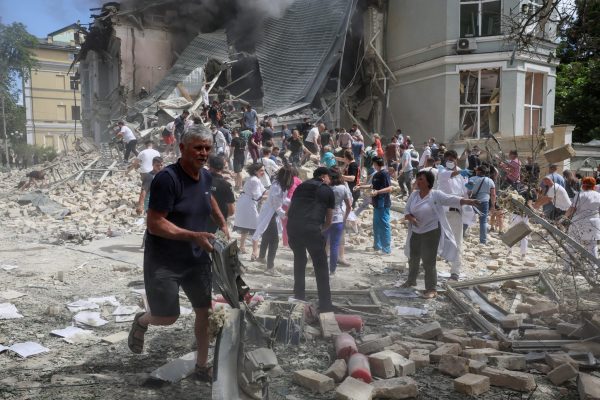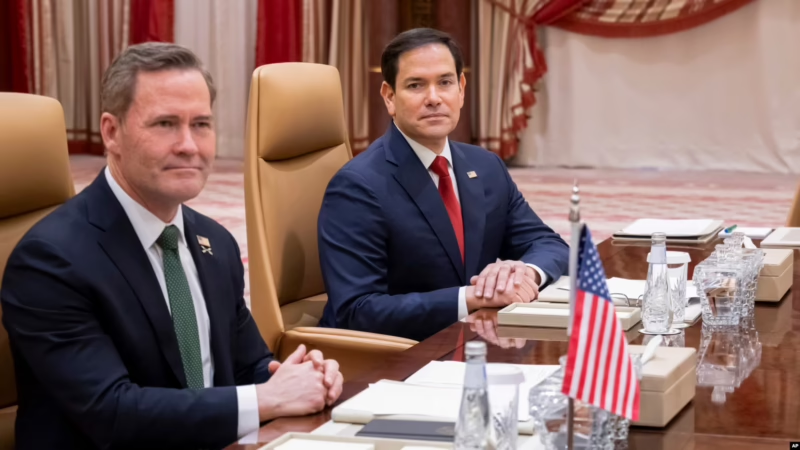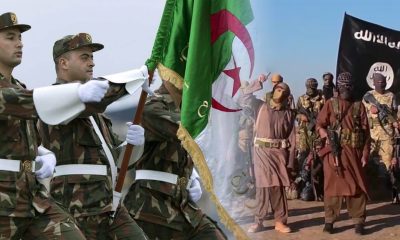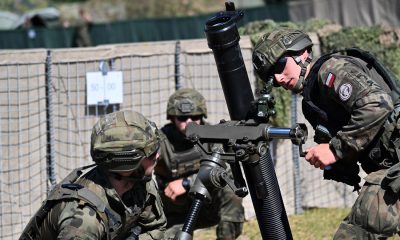Russia-Ukraine War
Russia Launches Third Ballistic Missile Attack on Kyiv

Ukrainian Air Defenses Intercept Most Missiles, Limited Damage Reported
Russia’s relentless missile barrage on Kyiv has reached a disturbing pattern. As the city endures its third ballistic attack this month, the stakes of the conflict escalate. As dawn broke over Kyiv on Sunday, the Ukrainian capital was plunged back into chaos, enduring its third ballistic missile assault this month alone. With Russian missiles raining down with unsettling precision, the frequency and intensity of these attacks paint a grim picture of an escalating conflict. The recurring pattern—attacks occurring at exact six-day intervals—raises troubling questions about Russia’s strategic intentions and its chilling methodical approach to warfare.
This latest barrage, characterized by the use of suspected North Korean-made ballistic missiles, has become a harrowing spectacle of destruction and defiance. While Ukrainian air defenses managed to intercept most of the incoming threats, the sheer audacity of Russia’s tactics reveals a brazen intent to destabilize and terrorize Kyiv. Reports from the front lines confirm that Ukrainian forces shot down five out of eight missiles, including a mix of ballistic, cruise, and guided aircraft missiles, but the relentless assault underscores the sophistication and persistence of the Russian offensive.
President Volodymyr Zelenskiy has condemned these attacks as deliberate acts of terror, describing them as calculated moves in Russia’s broader campaign to instill fear and chaos. With no immediate casualties reported from the latest strike, the physical damage includes the destruction of two private homes and significant damage to 16 others from debris. Yet, the psychological impact of such relentless bombardment is far more profound and damaging.
The timing and targeting of these strikes are particularly alarming. Just hours after the attack, fresh raid alerts blanketed Kyiv and the surrounding regions, signaling an ongoing and immediate threat. The city’s air defenses were thrust into high alert, grappling with the threat of further missile strikes. This constant state of readiness not only tests the resilience of Ukrainian defense systems but also heightens the city’s vulnerability to further aggression.
The wider context of these attacks paints an even darker picture. Since Russia’s full-scale invasion of Ukraine began two-and-a-half years ago, Moscow has captured roughly 18% of Ukrainian territory in the east and south. This relentless assault on Kyiv is not just a military strategy but also a psychological weapon aimed at eroding the morale and resolve of both the Ukrainian people and their defenders.
As the conflict drags on, the sophistication of Russia’s missile strikes and the frequency of these assaults suggest a calculated strategy to push Ukraine to its limits.
In this high-stakes game of cat and mouse, Ukraine’s air defenses are proving their mettle, but the frequency of these attacks hints at a troubling persistence in Russia’s strategy. The dire situation on the ground reflects a broader geopolitical struggle, where each missile launch is a grim reminder of the enduring conflict and the severe human cost of war.
As Kyiv braces for potential further attacks and the world watches, the question remains: how many more times will Kyiv face the brutal reality of ballistic terror before a resolution is reached?
Analysis
U.S. Pulls Out of Key Ukraine Arms Hub in Poland: Strategic Streamlining or Silent Retreat?

As the U.S. downsizes at Poland’s Jasionka base, questions rise over NATO cohesion, Trump’s intentions, and Europe’s defense future.
The U.S. military’s quiet exit from the Jasionka logistics hub — the lifeline of Ukraine’s war effort — is more than just a “streamlining” of operations. It’s a seismic signal: Washington is pulling back from the frontlines of European defense, and the implications are explosive.
Since 2022, Jasionka has been ground zero for NATO’s weapons pipeline to Ukraine. It’s no exaggeration to say 95% of lethal aid has passed through this Polish corridor. And who ran it? U.S. forces — until now. As of this week, the baton has been handed to Norway, Germany, the U.K., and Poland. But the question looms: Why now — and at what cost?
The Pentagon calls this a long-planned realignment. But that’s spin. The real driver is Donald Trump’s shifting doctrine: America First, Europe second — if at all. His disdain for NATO has morphed from rhetoric into reality. His threats to abandon allies and his backdoor dealings with Russia aren’t whispers anymore; they’re warnings. With his trade war and open hostility toward Canada and Greenland, the unraveling of post-WWII Western alliances is already in motion.
Poland — NATO’s new poster child for military spending — isn’t the problem. With 4.7% of GDP going to defense, it’s more committed than most. Warsaw is doing its part. The real issue is what this U.S. drawdown means: America is testing the limits of alliance dependency, gauging how far it can push Europe into standing on its own.
What’s being quietly set up in the background is NATO’s Security Assistance and Training Command for Ukraine, a move to shift operational control from the U.S. to a broader — and perhaps weaker — European leadership model. Sure, this spreads the burden. But it also diffuses accountability and fractures unity.
Let’s not sugarcoat this: the removal of U.S. troops from a critical war zone logistics hub during a hot war is not efficiency. It’s a red flag. And it may be the first of many.
Europe must now face a hard truth: Trump’s America is no longer the bulwark it once was. And if NATO crumbles, the chaos that follows won’t stop at Ukraine’s borders. It will creep into the heart of Europe — and into the balance sheets, war rooms, and borders of every allied state that let its guard down.
This isn’t just a logistics shuffle. It’s a strategic withdrawal. And it should terrify every Western policymaker.
Analysis
Trump-Putin Call Underscores Russia’s Grip on Ukraine Talks

Despite limited ceasefire gestures, Putin continues to manipulate peace talks while consolidating gains—and Trump appears to be offering leverage without returns.
The latest phone call between Donald Trump and Vladimir Putin has done little to shift the trajectory of Russia’s war in Ukraine. If anything, it has underscored how adept the Kremlin remains at stalling substantive peace efforts while subtly manipulating diplomatic optics.
From the outset, the optics were clear: Putin made Trump wait, quite publicly, to assert dominance—not only for his domestic audience but also to reinforce his standing in the bilateral dynamic. Delays, vague statements, and selective concessions are all hallmarks of Moscow’s diplomatic playbook—and in this case, they’re working to Russia’s advantage.
The only apparent outcome from the call—a 30-day pause on attacks targeting Ukraine’s energy infrastructure—is minimal and strategically convenient for Russia. It allows the Kremlin to reduce international pressure while preserving its ability to press ground offensives and conduct strikes on civilian and military targets outside of power grids.
Meanwhile, Trump’s response has been muted and ambiguous, presenting the energy ceasefire as a broader agreement than it actually is, while giving Putin space to dictate terms under the guise of cooperation. The Kremlin’s version of events suggests Trump proposed the ceasefire, which is highly unlikely given how favorable it is to Russia. It’s more plausible that Putin offered it as a limited gesture—cheap to implement, easy to reverse, and beneficial to his forces.
The Asymmetry in Negotiating Power
What’s striking is the imbalance in approach. Putin continues to pursue maximalist objectives: controlling Ukraine’s trajectory, maintaining annexed territory, and ending Western military support to Kyiv. Yet Trump has already begun softening the American position—freezing aid, engaging in talks without Ukraine present, and signaling acceptance of territorial compromise.
Each of these concessions undermines Ukraine’s negotiating position while enabling Russia to consolidate gains. The fact that Trump entertained such talks without Zelensky’s input is a glaring breach of diplomatic norms and weakens the principle of Ukrainian sovereignty.
Moreover, Putin’s demands—including halting Western military assistance and accepting Ukraine’s demilitarization—remain outlandish and designed to be rejected. They serve more as propaganda tools than serious proposals, allowing Moscow to cast Kyiv as the uncooperative party.
A War of Imperial Design
The core issue remains unchanged: Russia’s war aims have not shifted. Putin seeks nothing less than the geopolitical subjugation of Ukraine and the formal absorption of illegally annexed territories. The integration of these regions into the Russian Federation—via treaty and policy—is not merely occupation; it is attempted annexation by force.
This war was never about self-defense or NATO expansion. It has always been an imperial project cloaked in manufactured grievances and legal distortions. That Moscow continues to refer to Ukraine’s leadership as untrustworthy or “terrorist” only reinforces its refusal to treat Ukraine as a legitimate sovereign equal.
Zelensky’s Calculated Restraint
President Volodymyr Zelensky’s cautious response to the Trump-Putin call reveals both his diplomatic pragmatism and the constraints under which Kyiv operates. By not directly rejecting the partial ceasefire and avoiding criticism of Trump, Zelensky aims to preserve U.S. backing, however unpredictable it may be.
But Ukraine’s red lines remain unchanged: territorial sovereignty, independent alliances, and unrestricted defense capabilities. These are non-negotiable principles for Kyiv and its supporters.
Freezing the conflict at current front lines—effectively locking in Russian gains—may be seen by some as a path to ending the war. But such a solution lacks credibility unless it includes Russia revoking its annexations and allowing international oversight in the disputed regions.
Conclusion
Trump’s call with Putin highlights a troubling pattern: a U.S. president eager for a symbolic peace deal, increasingly susceptible to Kremlin flattery and delay tactics, while giving away leverage that could have been used to demand meaningful concessions.
Putin’s war aims remain fully intact. His strategy is simple—stretch out negotiations, maintain military pressure, and bank on Western fatigue. As Trump signals flexibility and rewards half-measures, the danger is not just a frozen conflict, but a normalization of aggression.
Any peace without justice, sovereignty, and accountability risks becoming a prelude to future conflict—and a gift to authoritarianism.
Russia-Ukraine War
Vladimir Putin Sets out Conditions for Ukraine Ceasefire

Putin expresses conditional support for a ceasefire, complicating US efforts to stabilize the region.
Russian President Vladimir Putin has expressed conditional agreement to a proposed 30-day ceasefire in Ukraine, positing several demanding stipulations that underscore the complexity of reaching a peace agreement. This response follows a week of intensified diplomacy involving the United States, which saw Ukraine aligning with a US-backed ceasefire plan.
During a press conference, Putin highlighted his support for the ceasefire concept but raised significant concerns about its execution and the strategic intentions behind it. His demands include clarifications on how Ukraine might use the ceasefire period, such as whether it would mobilize or rearm—actions that Russia views as escalatory.
The dialogue has revealed a stark divide in expectations. Ukrainian President Volodymyr Zelensky criticized Putin’s approach as manipulative, urging for increased sanctions on Russia to deter further aggression. Concurrently, the U.S. has escalated sanctions targeting Russia’s critical sectors, aiming to tighten economic pressure.
A scheduled discussion between Putin and US President Donald Trump’s envoy, Steve Witkoff, intended to further negotiations, remains shrouded in mystery with conflicting reports about its occurrence and outcomes. This ambiguity adds to the tension and uncertainty surrounding the ceasefire talks.
Putin’s detailed inquiries into the ceasefire’s mechanics and the control measures reflect a deep-seated mistrust and the complexities of enforcing peace in such a volatile context. His questions about command and compliance mechanisms highlight the challenges of implementing and monitoring a ceasefire over a broad geographic area.
As the international community watches closely, the prospects for a ceasefire remain uncertain. Putin’s stance indicates a strategic calculation, weighing the benefits of a temporary peace against the potential risks of Ukrainian military consolidation. This situation places significant pressure on President Trump, who has expressed a desire for quick resolutions to global conflicts.
The ongoing discussions and the stringent conditions set by Putin represent a pivotal moment in the Ukraine conflict. As both sides articulate their positions and international actors like the US involve themselves in mediating, the path to peace remains fraught with diplomatic hurdles and geopolitical calculations. The coming days will be crucial in determining whether a ceasefire can pave the way for a more stable resolution or if the conflict will continue to escalate amidst global tensions.
Russia-Ukraine War
Poland Seeks U.S. Nuclear Weapons Deployment as Russian Threat Looms

Amid heightened tensions with Russia, Poland’s President Duda calls for U.S. nuclear deterrents to secure the Eastern NATO frontier.
Poland’s President Andrzej Duda is intensifying his plea for the United States to deploy nuclear weapons on Polish soil, highlighting the nation’s growing security concerns in the face of Russian aggression. This request underscores Poland’s strategic position within NATO and its quest for enhanced military assurance against potential threats from its eastern neighbor.
Duda’s request, reiterated in a recent Financial Times interview and through his adviser Wojciech Kolarski on RMF FM radio, reflects Poland’s strategic military considerations. Positioned on NATO’s eastern border, sharing frontiers with Ukraine, Belarus, and Russia’s Kaliningrad, Poland views the presence of U.S. nuclear weapons as a crucial deterrent to Moscow’s expanding influence and military posture in the region.
The dialogue around nuclear protection in Europe is gaining complexity with Prime Minister Donald Tusk discussing potential collaboration with France. Following French President Emmanuel Macron’s offer to consider extending France’s nuclear deterrent to cover European allies, Poland is exploring all avenues to bolster its security framework. This move comes amid concerns about the U.S.’s sustained engagement in European defense, prompting leaders like Macron to propose strategic alternatives.
The Debate Over Nuclear Deterrence
The discussions about nuclear deterrence in Europe are not without controversy. Russia has already criticized Macron’s proposal as “extremely confrontational,” highlighting the delicate balance of power and the fine line between deterrence and provocation. As Europe grapples with these complex security dynamics, Poland’s call for U.S. nuclear weapons highlights the broader geopolitical chess game unfolding in response to Russian military activities.
Poland’s proactive stance on nuclear defense reflects a broader shift within NATO, where Eastern European nations are increasingly vocal about their security needs. This shift is significant, not just for regional defense strategies but also for the future of NATO’s collective security commitments. As Poland positions itself as a pivotal player in NATO’s eastern defense strategy, the alliance’s approach to Russia will likely continue to evolve, influenced by the security priorities of frontline states like Poland.
President Duda’s renewed appeal for U.S. nuclear weapons deployment in Poland is more than a security request; it is a strategic move aimed at reinforcing Poland’s position within NATO and the broader European security architecture. As global powers recalibrate their defense strategies in response to Russian threats, Poland’s nuclear ambitions will play a critical role in shaping the regional and international security landscape.
Russia-Ukraine War
U.S. Restarts Intelligence Sharing and Security Aid to Ukraine

The recent resumption of intelligence sharing and security assistance by the United States to Ukraine marks a pivotal moment in the ongoing conflict between Ukraine and Russia. This decision comes on the heels of extensive discussions in Jeddah, Saudi Arabia, where U.S. and Ukrainian officials expressed a united front on the proposed 30-day ceasefire with Russia, contingent upon Kremlin’s approval. The strategic shift underscores a significant diplomatic push by the Trump administration to de-escalate tensions and foster a resolution to the conflict that has gripped Eastern Europe since early 2022.
The U.S. pause on intelligence sharing, initiated on March 5, was widely perceived as a maneuver to compel Ukrainian President Volodymyr Zelenskyy into negotiations, signaling a stark approach to foreign policy under Trump’s administration. The reinstatement of these critical support structures signifies a recalibration of U.S. strategy, aiming not only to bolster Ukraine’s defensive capabilities but also to reaffirm commitments to its sovereignty and territorial integrity in the face of ongoing Russian aggression.
During the talks, which extended nearly eight hours, the Ukrainian delegation, led by Chief of Staff Andriy Yermak, showed a readiness to embrace the U.S. ceasefire proposal, a move that places considerable pressure on the Kremlin to respond favorably. The diplomatic dialogue in Jeddah, steered by U.S. Secretary of State Marco Rubio and National Security Adviser Mike Waltz, was crucial in shaping the framework for this ceasefire, highlighting a proactive role by the U.S. in seeking to mitigate further escalations.
The Kremlin’s delayed response to the ceasefire proposal, coupled with its minimal commentary on impending discussions, illustrates a cautious, calculated approach. Russia’s strategic ambiguity serves its interests by maintaining a posture that keeps the international community guessing about its next moves. However, this also opens a window for the U.S. and its allies to align their strategies and present a united front that could potentially corner Russia into a diplomatic resolution.
The ongoing conflict in Ukraine is not just a regional issue but a matter of global security that affects international law, energy markets, and the broader geopolitical landscape. The U.S.’s re-engagement with intelligence and security aid is a testament to the broader implications of the conflict, emphasizing the necessity for a stable Ukraine to ensure the security of the European continent and by extension, global peace.
Looking ahead, the dynamics of U.S.-Ukraine relations will hinge on the outcomes of the proposed ceasefire and subsequent negotiations with Russia. The discussions scheduled in the coming days between U.S. and Russian officials will be critical in shaping the course of the conflict. Furthermore, the potential mineral deal between the U.S. and Ukraine, leveraging Ukraine’s rich deposits for strategic and economic gains, introduces another layer of complexity to the international discourse surrounding this conflict.
In summary, the reinstatement of U.S. intelligence and security aid to Ukraine represents a strategic shift aimed at stabilizing the volatile situation through diplomatic channels. As the situation unfolds, the international community remains keenly watchful of the impacts this renewed engagement will have on the war’s trajectory and the broader geopolitical implications.
Russia-Ukraine War
US-Ukraine talks: Kyiv Supports Proposed 30-Day Ceasefire in War With Russia

The US-Ukraine talks held in Jeddah, Saudi Arabia, represent a pivotal moment in the ongoing efforts to bring peace to the war-torn regions affected by Russia’s invasion of Ukraine. The support from Kyiv for the U.S.-proposed 30-day ceasefire underscores a significant diplomatic push to quell hostilities and establish a groundwork for lasting peace.
The joint statement indicating Ukraine’s readiness to accept a temporary ceasefire suggests a strategic, although cautious, optimism towards achieving a de-escalation of conflict. The stipulation that the ceasefire’s success is contingent upon Russian reciprocity highlights the complex interplay of diplomatic engagements required to realize peace. The U.S. commitment to resume security assistance and lift the pause on intelligence sharing with Ukraine further aligns with its role as a key strategic ally, reaffirming its support in the face of Russian aggression.
The involvement of high-level officials, including U.S. Secretary of State Marco Rubio and National Security Adviser Mike Waltz, in these talks emphasizes the importance the U.S. places on resolving this conflict. The absence of Ukrainian President Volodymyr Zelenskyy, yet the presence of his chief of staff and top military officials, indicates a coordinated Ukrainian effort to align diplomatic strategies with military realities on the ground.
The discussion points raised during the meetings reflect a nuanced approach to diplomacy, where the U.S. appears to be in a listening mode, gauging what concessions Ukraine is prepared to make. This dialogue is critical as it shapes the framework within which both warring nations might navigate to achieve cessation of hostilities.
A notable aspect of these discussions is the focus on securing economic and security guarantees for Ukraine, aimed at ensuring that Russian aggression cannot be repeated. This includes talks on developing Ukraine’s critical mineral resources—an element that not only aims to bolster Ukraine’s economy but also integrates broader U.S. interests related to accessing strategic minerals crucial for its economy and national defense.
The involvement of Saudi Arabia, as evidenced by separate meetings held by Saudi Crown Prince Mohammed bin Salman with Rubio and Zelenskyy, showcases the kingdom’s growing role in mediating global conflicts. This diplomatic engagement by Saudi Arabia could signify a strategic pivot for the nation, seeking to assert its influence in global geopolitical matters beyond the Middle East.
The US-Ukraine talks in Jeddah mark a critical juncture in international efforts to address the conflict in Ukraine. With the proposed ceasefire and discussions on economic and security collaborations, there appears to be a concerted effort to forge a path toward peace. However, the effectiveness of these initiatives will heavily depend on the subsequent actions of Russia and the international community’s resolve to support Ukraine in maintaining sovereignty and security. As these diplomatic efforts unfold, the global community remains watchful, hopeful for a resolution that brings stability to the region and secures a peaceful future for Ukraine.
Commentary
Trump Confident Putin Wants Peace Despite Bombing Ukraine

President Donald Trump remains optimistic about his ability to broker peace between Russia and Ukraine, despite ongoing heavy bombardments by Russia on Ukrainian territory. In a recent statement, Trump indicated his confidence in Russian President Vladimir Putin’s intentions for peace, even as Russian forces continue their aggressive military campaign across Ukraine.
On Friday, Ukrainian authorities reported over 200 missile and drone strikes overnight, targeting energy infrastructure and causing damage to residential areas across five regions. Despite these attacks, Trump expressed a belief in Putin’s peaceful assertions, noting, “I believe him. I think we’re doing very well with Russia,” while acknowledging the harsh reality of the conflict: “They’re bombing the hell out of Ukraine.”
Trump’s approach to the situation has been marked by a blend of pragmatism and frustration, particularly towards Ukraine. He suggested that the challenges in dealing with Kyiv are greater than those with Moscow, citing Ukraine’s weaker negotiating position: “I’m finding it more difficult, frankly, to deal with Ukraine. They don’t have the cards.”
The U.S. president’s comments raised questions about further support for Ukraine, particularly in terms of air defense capabilities. Trump stated that any additional military aid would depend on Ukraine’s willingness to engage in peace talks, emphasizing his desire for a resolution: “I have to know that they want to settle. If they don’t want to settle, we’re out of there because we want them to settle.”
Amidst these developments, other U.S. officials have sought to clarify the administration’s stance. U.S. Director of National Intelligence Tulsi Gabbard emphasized that while there has been a pause in sharing intelligence that could facilitate Ukrainian offensives, defensive support remains steadfast: “Any intelligence going toward defending Ukraine against attacks coming into their country would continue.”
This stance is supported by the confirmation from a U.S. defense official that Ukraine continues to have access to crucial defensive tools like Starlink, enhancing its capability to counter Russian assaults.
In response to the ongoing Russian aggression, Ukrainian President Volodymyr Zelenskyy highlighted the effectiveness of Ukraine’s air defenses, mentioning the deployment of French-made Mirage fighter jets and U.S-made F-16s in repelling the attacks. Zelenskyy remains committed to peace, as evident from his active engagement with Trump’s team: “Intense work with President Trump’s team has been ongoing at various levels — numerous calls,” he posted on social media. “The topic is clear — peace as soon as possible, security as reliably as possible. Ukraine is fully committed to a constructive approach.”
However, Zelenskyy also voiced frustrations with Russia, asserting that the burden of initiating peace lies with Moscow, which needs to cease its military actions and engage in genuine diplomacy.
The unfolding situation underscores the complex dynamics of international diplomacy and conflict, with the U.S. playing a pivotal role in navigating the path to peace. The upcoming meeting between Zelenskyy and U.S. officials in Saudi Arabia to discuss a ceasefire marks a critical juncture in these efforts, reflecting ongoing attempts to stabilize the region amidst one of the most challenging geopolitical conflicts of recent times.
Russia-Ukraine War
Europe Rallies for Ukraine as U.S. Wavers: A New Defense Paradigm

The geopolitical landscape of the Russia-Ukraine war shows no signs of stability, as U.S. uncertainty casts long shadows over peace prospects, while European unity strengthens around Ukraine. The recent London summit, led by British Prime Minister Keir Starmer, marked a crucial juncture, underscoring Europe’s readiness to shoulder greater responsibility in securing regional peace without assured U.S. backing.
This shift comes in the aftermath of a heated exchange between U.S. President Donald Trump and Ukrainian President Volodymyr Zelenskyy, which vividly highlighted the growing rift between U.S. intentions and European security ambitions. Starmer’s call to action at the summit was a clear signal: Europe must now lead the charge in fortifying Ukraine against ongoing Russian aggression, possibly without robust U.S. military support.
The summit’s discourse was sharply contrasted by Trump’s ambivalence, as he questioned Zelenskyy’s readiness for peace, suggesting a misalignment with U.S. goals to end the conflict. This stance has visibly strained transatlantic relations, with European leaders rallying support for Kyiv and reaffirming commitments to enhance defense spending and deploy peacekeeping forces, should a truce materialize.
In contrast to the discord in Washington, Zelenskyy received a warm reception in London, reflecting widespread European and Canadian backing. This support is not just rhetorical but is also being cemented financially; Starmer unveiled a significant loan agreement aimed at bolstering Ukraine’s defense capabilities, funded by the immobilization of Russian assets.
Moreover, the European commitment extends beyond financial aid. The EU’s Ursula von der Leyen’s call to “prepare for the worst” by rearming Europe indicates a proactive approach to defense, mirroring the serious considerations being given to a European-led peacekeeping mission, a notion backed by French President Emmanuel Macron’s advocacy for a European nuclear deterrent.
As the U.S. continues to send mixed signals—with Trump’s national security adviser hinting at potential concessions needed for peace—the European bloc remains steadfast in its support for Ukraine, ready to intervene with peacekeeping forces if necessary. This collective stance not only challenges Putin’s aggressive maneuvers but also underscores a significant shift towards European autonomy in defense matters.
The unfolding scenario paints a complex picture of alliances and strategies, where European solidarity and proactive defense posturing could redefine regional security dynamics, potentially without the erstwhile reliance on U.S. military might. As discussions evolve, the international community remains watchful of how this new paradigm will influence the ongoing conflict and reshape the geopolitical landscape.
-

 Analysis1 month ago
Analysis1 month agoSaudi Arabia’s Billion-Dollar Bid for Eritrea’s Assab Port
-

 ASSESSMENTS3 weeks ago
ASSESSMENTS3 weeks agoOperation Geel Exposes the Truth: International Community’s Reluctance to Embrace Somaliland as a Strategic Ally
-

 Somaliland3 months ago
Somaliland3 months agoSomaliland and UAE Elevate Ties to Comprehensive Strategic Partnership
-

 Africa1 year ago
Africa1 year agoHow Somaliland Could Lead the Global Camel Milk Industry
-

 Analysis1 year ago
Analysis1 year agoIran escalates conflict, attacking Israel; US forces help Israel to intercept Iranian projectiles
-

 Top stories11 months ago
Top stories11 months agoGunmen Kill 11 in Southeastern Nigeria Attack, Army Reports
-

 Analysis1 year ago
Analysis1 year agoIsrael and Iran on Edge: Tensions Escalate Amidst Rising Threats
-

 TECH11 months ago
TECH11 months agoZimbabwe Approves Licensing of Musk’s Starlink Internet Service






























